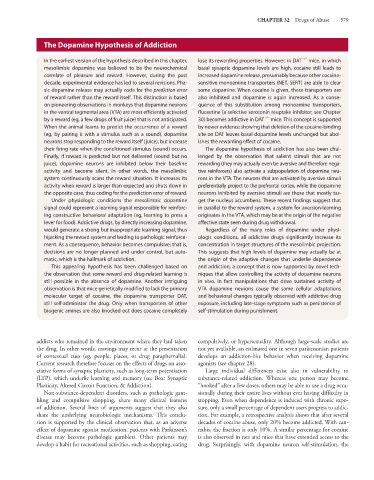Page 593 - Basic _ Clinical Pharmacology ( PDFDrive )
P. 593
CHAPTER 32 Drugs of Abuse 579
The Dopamine Hypothesis of Addiction
–/–
In the earliest version of the hypothesis described in this chapter, lose its rewarding properties. However, in DAT mice, in which
mesolimbic dopamine was believed to be the neurochemical basal synaptic dopamine levels are high, cocaine still leads to
correlate of pleasure and reward. However, during the past increased dopamine release, presumably because other cocaine-
decade, experimental evidence has led to several revisions. Pha- sensitive monoamine transporters (NET, SERT) are able to clear
sic dopamine release may actually code for the prediction error some dopamine. When cocaine is given, these transporters are
of reward rather than the reward itself. This distinction is based also inhibited and dopamine is again increased. As a conse-
on pioneering observations in monkeys that dopamine neurons quence of this substitution among monoamine transporters,
in the ventral tegmental area (VTA) are most efficiently activated fluoxetine (a selective serotonin reuptake inhibitor, see Chapter
–/–
by a reward (eg, a few drops of fruit juice) that is not anticipated. 30) becomes addictive in DAT mice. This concept is supported
When the animal learns to predict the occurrence of a reward by newer evidence showing that deletion of the cocaine-binding
(eg, by pairing it with a stimulus such as a sound), dopamine site on DAT leaves basal dopamine levels unchanged but abol-
neurons stop responding to the reward itself (juice), but increase ishes the rewarding effect of cocaine.
their firing rate when the conditioned stimulus (sound) occurs. The dopamine hypothesis of addiction has also been chal-
Finally, if reward is predicted but not delivered (sound but no lenged by the observation that salient stimuli that are not
juice), dopamine neurons are inhibited below their baseline rewarding (they may actually even be aversive and therefore nega-
activity and become silent. In other words, the mesolimbic tive reinforcers) also activate a subpopulation of dopamine neu-
system continuously scans the reward situation. It increases its rons in the VTA. The neurons that are activated by aversive stimuli
activity when reward is larger than expected and shuts down in preferentially project to the prefrontal cortex, while the dopamine
the opposite case, thus coding for the prediction error of reward. neurons inhibited by aversive stimuli are those that mostly tar-
Under physiologic conditions the mesolimbic dopamine get the nucleus accumbens. These recent findings suggest that
signal could represent a learning signal responsible for reinforc- in parallel to the reward system, a system for aversion-learning
ing constructive behavioral adaptation (eg, learning to press a originates in the VTA, which may be at the origin of the negative
lever for food). Addictive drugs, by directly increasing dopamine, affective state seen during drug withdrawal.
would generate a strong but inappropriate learning signal, thus Regardless of the many roles of dopamine under physi-
hijacking the reward system and leading to pathologic reinforce- ologic conditions, all addictive drugs significantly increase its
ment. As a consequence, behavior becomes compulsive; that is, concentration in target structures of the mesolimbic projection.
decisions are no longer planned and under control, but auto- This suggests that high levels of dopamine may actually be at
matic, which is the hallmark of addiction. the origin of the adaptive changes that underlie dependence
This appealing hypothesis has been challenged based on and addiction, a concept that is now supported by novel tech-
the observation that some reward and drug-related learning is niques that allow controlling the activity of dopamine neurons
still possible in the absence of dopamine. Another intriguing in vivo. In fact manipulations that drive sustained activity of
observation is that mice genetically modified to lack the primary VTA dopamine neurons cause the same cellular adaptations
molecular target of cocaine, the dopamine transporter DAT, and behavioral changes typically observed with addictive drug
still self-administer the drug. Only when transporters of other exposure, including late-stage symptoms such as persistence of
biogenic amines are also knocked out does cocaine completely self-stimulation during punishment.
addicts who remained in the environment where they had taken compulsively, or hypersexuality. Although large-scale studies are
the drug. In other words, cravings may recur at the presentation not yet available, an estimated one in seven parkinsonian patients
of contextual cues (eg, people, places, or drug paraphernalia). develops an addiction-like behavior when receiving dopamine
Current research therefore focuses on the effects of drugs on asso- agonists (see chapter 28).
ciative forms of synaptic plasticity, such as long-term potentiation Large individual differences exist also in vulnerability to
(LTP), which underlie learning and memory (see Box: Synaptic substance-related addiction. Whereas one person may become
Plasticity, Altered Circuit Function, & Addiction). “hooked” after a few doses, others may be able to use a drug occa-
Non-substance-dependent disorders, such as pathologic gam- sionally during their entire lives without ever having difficulty in
bling and compulsive shopping, share many clinical features stopping. Even when dependence is induced with chronic expo-
of addiction. Several lines of arguments suggest that they also sure, only a small percentage of dependent users progress to addic-
share the underlying neurobiologic mechanisms. This conclu- tion. For example, a retrospective analysis shows that after several
sion is supported by the clinical observation that, as an adverse decades of cocaine abuse, only 20% become addicted. With can-
effect of dopamine agonist medication, patients with Parkinson’s nabis, the fraction is only 10%. A similar percentage for cocaine
disease may become pathologic gamblers. Other patients may is also observed in rats and mice that have extended access to the
develop a habit for recreational activities, such as shopping, eating drug. Surprisingly, with dopamine neuron self-stimulation, the

